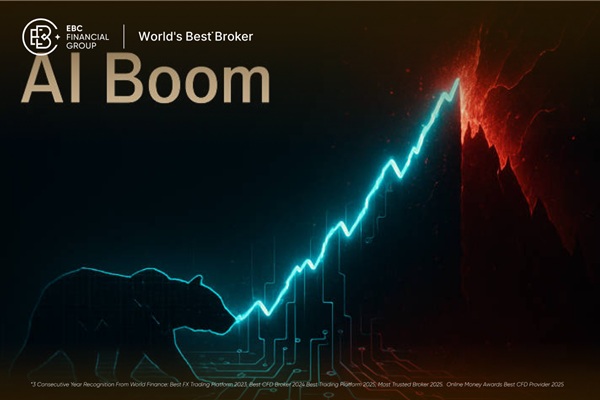AI stocks are no longer a niche play, they’re at the center of one of the most powerful investment trends of our time.
In 2025, the sector is being reshaped by record-breaking earnings from chipmakers, aggressive AI rollouts from cloud giants, and a surge of capital into next-generation software platforms.
For investors, the question has shifted from whether to own AI exposure to how to position portfolios for both upside potential and risk management. With valuations high, competition intensifying, and institutional money driving sector rotation, identifying the right AI stocks could define portfolio performance for years to come.

What Does AI Look Like in 2025?
The trajectory of AI's development has been profoundly transformative. Breakthroughs such as OpenAI's ChatGPT and Google's Gemini AI model exemplify the expanding capabilities of AI systems and their integration into everyday applications.
Microsoft reaffirmed that its OpenAI partnership remains in force through 2030, with Copilot, GitHub Copilot and Azure AI deeply integrated across its product stack, strengthening the enterprise AI story for 2025.
The widespread adoption of AI, anticipated to peak in 2025, is prompting companies across sectors to accelerate their investments in AI-driven solutions. This surge in AI utilisation and the integration of AI technology has also generated an unprecedented demand for computational infrastructure, positioning hardware providers as indispensable players in the AI ecosystem.
2025 is also a hardware transition year: NVIDIA’s Blackwell platform is rolling out to power the next wave of AI workloads, while foundry and packaging capacity (e.g., TSMC CoWoS) continues to expand to meet demand. Memory leaders are benefitting too as HBM becomes the backbone of AI data centers.
How Do AI Applications Affect the Stock Market?
AI technologies are driving significant disruption across domains including healthcare, finance, education, and entertainment. This proliferation is catalysing substantial growth in AI stock valuations, fuelled by investor confidence in the long-term profitability of AI-integrated enterprises and their AI exposure. Companies are increasingly leveraging proprietary data to develop tailored AI applications, creating unique competitive advantages within specific industries. While immediate financial returns may be limited, stock valuations often reflect projected future performance, making 2025 a critical year for strategic AI investments.
A key shift in 2025 is the move from infrastructure build-out to software monetization via AI “agents.” Goldman Sachs estimates the application-software market could reach ~$780B by 2030, as agents unlock productivity and new revenue streams.
Which AI Stocks Should You Watch in 2025?
Several industry leaders are emerging as frontrunners in the AI revolution. AI models play a crucial role in enhancing productivity and automating processes across various sectors. Key players include:
-
Nvidia:
Renowned for its high-performance GPUs, Nvidia is essential for enabling advanced AI functionalities such as deep learning and autonomous systems. In 2025, the Blackwell generation and ongoing advanced-packaging ramps aim to lift data-center throughput for training and inference.
-
Microsoft:
With a strategic $13 billion investment in OpenAI, Microsoft has seamlessly integrated ChatGPT into its Bing search engine and continues to expand its AI offerings. Microsoft says core OpenAI access and revenue-sharing remain intact through 2030, underpinning Copilot’s enterprise roll-out across Microsoft 365, GitHub and Azure AI.
-
Alphabet Inc. (Google):
Alphabet leverages AI across its operations, from search algorithms and advertising to cloud computing services, solidifying its position as an AI powerhouse. Gemini continues to roll out across Workspace with new upgrades (Gmail/Docs/Meet/Vids), increasing day-to-day usage and enterprise stickiness.
-
Amazon:
By embedding AI into its recommendation systems, targeted advertising, and logistical frameworks, Amazon has established itself as a leader in AI-driven innovation. AWS is deepening its collaboration with Anthropic (Claude on Bedrock), reinforcing Amazon’s strategy to monetize AI via cloud infrastructure and model access.
-
Micron (MU):
A prime HBM and DRAM beneficiary as AI data-center builds accelerate; raised FY outlook on stronger AI memory demand.
-
TSMC (2330.TW):
The world’s leading AI chip foundry and advanced-packaging provider (CoWoS), posting record profits on AI demand and guiding for continued strength.
How Should You Evaluate AI Stocks?
Investors seeking to capitalise on AI-driven growth should consider the following factors:
Strategic Utilisation of AI: Does the company employ AI tools to enhance content generation, analytics, and automation capabilities, thereby securing a competitive market advantage?
Domain Expertise and Market Positioning: Assess the company's proficiency in AI and its influence within the industry.
Valuation Metrics and Growth Projections: Evaluate current valuations against anticipated growth trajectories.
Revenue Monetisation Strategies: Analyse the company's ability to convert AI innovations into sustainable revenue streams.
Data Advantage & Distribution: Companies with proprietary data moats and strong distribution (cloud, productivity suites, or installed enterprise bases) are better positioned to monetize agents and copilots at scale.
What Risks and Challenges Do AI Stocks Face?
Despite its transformative potential, investing in AI stocks entails inherent risks:
Market Valuation Pressures: Elevated expectations may not align with actual financial outcomes.
Generative AI Competition: The rise of generative AI introduces both disruptive opportunities and formidable challenges, highlighting the 'AI promises' of driving innovation and productivity.
Infrastructure Bottlenecks: Limited data centre capacities could constrain growth in the AI sector.
Packaging & Supply Constraints: Advanced packaging (e.g., CoWoS-L) remains a potential bottleneck during new GPU cycles, even as capacity expands.
Energy & Cost Pressure: Rapid AI growth raises power-consumption and cost considerations that can affect deployment timelines and margins.
-
Revenue Ambiguity: Cloud service providers must demonstrate clear, incremental revenue streams attributable to AI innovations to justify their valuations.

What's Next for AI in the Stock Market?
AI stocks will continue to serve as a driving force within financial markets throughout 2025 and beyond, offering significant market potential and investment strategies. Companies that excel in developing, deploying, and scaling AI applications are poised for sustained growth.
As these technologies mature, their broader influence on market dynamics will become increasingly evident, with AI stocks expected to play a pivotal role in delivering substantial returns.
Expect a two-phase cycle: hardware-led growth persists, while agent-driven software monetization broadens the profit pool over the next few years.
Are Generative-AI Startups Challenging the Tech Giants?
The ascendance of AI startups is reshaping competitive dynamics within the technology sector. Generative AI technologies are playing a vital role in enhancing productivity and enabling autonomous actions by processing user prompts to create content such as text, images, and code. While established players such as Microsoft and Google maintain significant advantages, startups like OpenAI are rapidly gaining traction, bolstered by substantial funding and innovative approaches.
The hyperscalers’ distribution and capex remain formidable, but startups can still win by specializing (vertical data, compliance, or workflow depth) and then partnering for scale.
Access to vast, high-quality datasets remains a critical differentiator, enabling certain companies to achieve breakthroughs in AI development.
How Should You Invest in AI Stocks?
To navigate the complexities of AI investment, consider the following recommendations:
Prioritise companies with robust financials, reasonable valuations, and a proven track record of innovation.
Focus on entities with deep AI expertise and demonstrated success in monetising AI products, particularly those leveraging machine learning to enhance customer experiences and remain relevant in the market.
Evaluate the potential risks associated with market volatility and competitive pressures.
Quick framework:
Barbell it: mix hardware (chips, foundry, memory) with software (agents/coplots/security) to balance cycles.
Follow adoption, not headlines: prioritize products with clear usage (seats, MAUs, API calls).
Watch bottlenecks: supply, power, and regulatory shifts can move timelines.
As the artificial intelligence (AI) revolution continues to transform industries and drive growth, investors are eager to capitalise on the trend. With the AI stock market expected to see huge growth potential in 2025, it's essential to navigate the landscape carefully. In this article, we’ve highlighted the top AI stocks to buy, including Nvidia, Microsoft, Alphabet Inc., and Amazon.
However, it's crucial to remember that not all AI stocks are created equal. While some companies are well-positioned to benefit from the AI boom, others may face significant challenges. As we've seen with companies like Super Micro Computer, Palantir Technologies, and SoundHound AI, even premier AI stocks can face significant downside risks.
To succeed in the stock market, investors must be aware of the key trends and developments shaping the industry. This includes the rise of generative AI, the growth of AI agents, and the increasing importance of large language models. By staying informed and adapting to the changing landscape, investors can make informed decisions and capitalise on the opportunities presented by the AI revolution.
Ultimately, investing in AI stocks requires a deep understanding of the technology, the companies involved, and the market trends. As the Motley Fool Stock Advisor analyst team has identified, the 10 best stocks for investors to buy now may not include some of the most popular technology stocks. By taking a nuanced approach and considering multiple perspectives, investors can navigate the AI stock market with confidence and achieve long-term success.
Most Asked Questions About AI Stocks:
Which AI stocks look strongest right now?
NVIDIA and TSMC lead on infrastructure, while Microsoft, Alphabet and Amazon monetize AI through software and cloud. Memory maker Micron benefits from HBM demand.
Are valuations too high for AI stocks?
Valuations largely reflect strong demand and multi-year capex cycles, but results can be lumpy, expect volatility around supply and deployment.
Should I focus on hardware or software?
Both. Hardware captures today’s build-out; software (agents/coplots) broadens monetization over time.
What new risks should I watch in 2025?
Advanced-packaging capacity, power/energy constraints, and shifting regulations.
How can I evaluate AI adoption?
Look for real usage data: paid seats, Copilot/Gemini activation, API consumption and retention.
Is diversification across AI sub-sectors helpful?
Yes, balancing chips, foundry/packaging, memory, cloud platforms, and application software helps smooth single-segment shocks.

Bottom Line on AI Stocks
AI stock market presents both opportunities and challenges for investors. Keep your eyes on the market, adapting to changing trends, and taking a nuanced approach, investors can navigate the landscape and capitalise on the growth potential of artificial intelligence stocks. Whether you’re a seasoned investor or just starting, it's essential to remember that the AI revolution is still in its early stages, and the best is yet to come.
Disclaimer: This material is for general information purposes only and is not intended as (and should not be considered to be) financial, investment or other advice on which reliance should be placed. No opinion given in the material constitutes a recommendation by EBC or the author that any particular investment, security, transaction or investment strategy is suitable for any specific person.





























